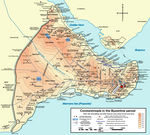Sirkeci railway station

Sirkeci railway station (Turkish: Sirkeci garı), listed on maps as Istanbul railway station (Turkish: İstanbul garı), is a railway terminal in Istanbul, Turkey. The terminal is located in Sirkeci, on the tip of Istanbul's historic peninsula, right next to the Golden Horn and just northwest of Gülhane Park and the Topkapı Palace. Sirkeci Terminal on the European side of the Bosporus strait, along with Haydarpaşa Terminal on the Asian side, are Istanbul's two intercity and commuter railway terminals. Built in 1890 by the Oriental Railway as the eastern terminus of the world-famous Orient Express that once operated between Paris and Istanbul in the period between 1883 and 2009, Sirkeci Terminal has become a symbol of the city. As of 19 March 2013, service to the station was indefinitely suspended due to the rehabilitation of the existing line between Kazlıçeşme and Halkalı for the new Marmaray commuter rail line. On 29 October 2013, a new underground station was opened to the public and is serviced by Marmaray trains travelling across the Bosphorus. Sirkeci Terminal has a total of 4 platforms (3 above, 1 underground) with 7 tracks (5 above, 2 underground). Formerly, commuter trains to Halkalı would depart from tracks 2, 3 and 4; while regional trains to Kapıkule, Edirne and Uzunköprü, along with international trains to Bucharest, Sofia and Belgrade would depart from tracks 1 and 5.
Excerpt from the Wikipedia article Sirkeci railway station (License: CC BY-SA 3.0, Authors, Images).Sirkeci railway station
Vezir Camii Çıkmazı Sokağı, Istanbul
Geographical coordinates (GPS) Address External links Nearby Places Show on map
Geographical coordinates (GPS)
| Latitude | Longitude |
|---|---|
| N 41.015 ° | E 28.977222 ° |
Address
İstanbul-Sirkeci
Vezir Camii Çıkmazı Sokağı
34110 Istanbul
Türkiye
Open on Google Maps







